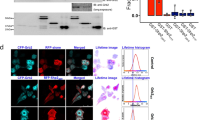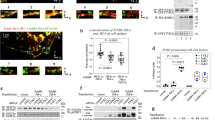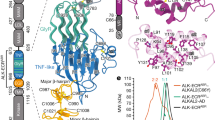Abstract
Heterotrimeric guanine-nucleotide-binding regulatory proteins (G proteins) transduce signals from a wide variety of cell-surface receptors to generate physiological responses1. Protein-tyrosine kinases are another group of critical cellular signal transducers and their malfunction often leads to cancer2. Although activation of G-protein-coupled receptors can elicit rapid stimulation of cellular protein-tyrosine phosphorylation3, the mechanism used by G proteins to activate protein-tyrosine kinases is unclear. Here we show that the purified α-subunit of the Gq class of G proteins (Gαq) directly stimulates the activity of a purified non-receptor kinase, Bruton's tyrosine kinase (Btk)4, whereas purified α-subunits from Gi1, GO or Gz proteins do not. Gαq can also activate Btk in vivo. Furthermore, in Btk-deficient cells, stimulation of another kinase, a p38 MAP kinase, by Gq-coupled receptors is blocked. Our results demonstrate that certain protein-tyrosine kinases can be direct effectors of G proteins.
This is a preview of subscription content, access via your institution
Access options
Subscribe to this journal
Receive 51 print issues and online access
$199.00 per year
only $3.90 per issue
Buy this article
- Purchase on Springer Link
- Instant access to full article PDF
Prices may be subject to local taxes which are calculated during checkout


Similar content being viewed by others
References
Gilman, A. Gproteins: transducers of receptor-generated signals. Annu. Rev. Biochem. 56, 615–649 (1987).
Hunter, T. & Cooper, J. A. Protein-tyrosine kinases. Annu. Rev. Biochem. 54, 897–930 (1985).
Hollenberg, M. D. Tyrosine kinase pathways and the regulation of smooth muscle contractility. Trends Pharmacol. Sci. 15, 108–114 (1994).
Satterthwaite, A. & Witte, O. Genetic analysis of tyrosine kinase function in B cell development. Annu. Rev. Immunol. 14, 131–154 (1996).
Kozasa, T. & Gilman, A. G. Purification of recombinant G proteins from Sf9 cells by hexahistidine tagging of associated subuits. J. Biol. Chem. 270, 1734–1741 (1995).
Amrein, K. E., Takacs, B., Stieger, M., Molnos, J., Flint, N. A. & Burn, P. Purification and characterization of recombinant human p50csk protein-tyrosine kinase from an Escherichia coli expression system overproducing the bacterial chaperones GroES and GroEL. Proc. Natl Acad. Sci. USA 92, 1048–1052 (1995).
Flint, N. A., Amrein, K. E., Jascur, T. & Burn, P. Purification and characterization of an activated form of the protein tyrosine kianse Lck from an Escherichia coli expression system. J. Cell. Biochem. 55, 389–397 (1994).
Lindberg, R. A. & Pasquale, E. Isolation of cDNA clones that encode active protein-tyrosine kinases using antibodies against phosphotyrosine. Meth. Enzymol. 200, 557–577 (1991).
Park, H.et al. Regulation of Btk function by a major autophosphorylation site within the SH3 domain. Immunity 4, 515–525 (1996).
Smrcka, A. V., Hepler, J. R., Brown, K. O. & Sterweis, P. C. Regulation of polyphosphoinositide-specific phospholipase C activity by purified Gq. Science 251, 804–807 (1991).
Lee, C.-W., Lee, K.-H., Lee, S.-B., Park, D. & Rhee, S. G. Regulation of phospholipase C-β4 by ribonucleotides and the α subunit of Gq. J. Biol. Chem. 269, 25335–25338 (1994).
Hepler, J. R. et al. Functional importance of the amino terminus of Gqα. J. Biol. Chem. 271, 496–504 (1996).
Bigay, J., Deterre, P., Pfister, C. & Chabre, M. Fluoride complexes of aluminium or beryllium act on G-proteins as reversibly bound analogues of the γ phosphate of GTP. EMBO J. 6, 2907–2913 (1987).
Qian, N.-X., Winitz, S. & Johnson, G. L. Epitope-tagged Gq α subunits: Expression of GTPase-deficient α subunits persistently stimulates phosphatidylinositol-specific phospholipase C but not mitogen-activated protein kinase activity regulated by the M1 muscarinic acetylcholine receptor. Proc. Natl Acad. Sci. USA 90, 4077–4081 (1993).
Wan, Y. et al. Genetic evidence for a tyrosine kinase cascade preceding the mitogen-activated protein kinase cascade in vertebrate G protein signaling. J. Biol. Chem. 272, 17209–17215 (1997).
Han, J., Lee, J. D., Bibbs, L. & Ulevitch, R. J. AMAP kinase targeted by endotoxin and hyperosmolarity in mammalian cells. Science 265, 808–811 (1994).
Pandey, P. et al. Activation of p38 mitogen-activated protein kinase by c-Abl-dependent and -independent mechanisms. J. Biol. Chem. 271, 23775–23779 (1996).
Kramer, R. M., Roberts, E. F., Strifler, B. A. & Johnstone, E. M. Thrombin induces activation of p38 MAP kinase in human platelets. J. Biol. Chem. 270, 27395–27398 (1995).
Krump, E., Sanghera, J. S., Pelech, S. L., Furuya, W. & Grinstein, S. Chemotactic peptide N-formyl-Met-Leu-Phe activation of p38 mitogen-activated protein kinase (MAPK) and MAPK-activated protein kinase-2 in human neutrophils. J. Biol. Chem. 272, 937–944 (1997).
Andreotti, A. H., Brunnell, S. C., Feng, S., Berg, L. J. & Schreiber, S. L. Regulatory intramolecular association in a tyrosine kinase of the Tec family. Nature 385, 93–97 (1997).
Taylor, S. J., Chae, H. Z., Rhee, S. G. & Exton, J. H. Activation of the β1 isozyme of phospholipase C by α-subunits of the Gq class of G proteins. Nature 350, 516–518 (1991).
Boyer, J. L., Graber, S. G., Waldo, G. L., Harden, T. K. & Garrison, J. S. Selective activation of phospholipase C by recombinant G-protein α and βγ subunits. J. Biol. Chem. 269, 2814–2819 (1994).
Bolen, J. B. Protein tyrosine kinases in the initiation of antigen receptor signaling. Curr. Opin. Immunol. 7, 306–311 (1995).
Lemmon, M. A., Ferguson, K. M. & Schlessinger, J. PH domains: diverse sequences with a common fold recruit signaling molecules to the cell surface. Cell 85, 621–624 (1996).
Langhans-Rajasekaran, S. A., Wan, Y. & Huang, X.-Y. Activation of Tsk and Btk tyrosine kinases by G protein βγ subunits. Proc. Natl Acad. Sci. USA 92, 8601–8605 (1995).
Wan, Y., Kurosaki, T. & Huang, X.-Y. Tyrosine kinases in activation of the MAP kinase cascade by G-protein-coupled receptors. Nature 380, 541–544 (1996).
Price, D. J., Kawakami, Y., Kawakami, T. & Rivnay, B. Purification of a major tyrosine kinase from RBL-2H3 cells phosphorylating FcεRI γ-cytoplasmic domain and identification as the Btk tyrosine kinase. Biochim. Biophys. Acta 1265, 133–142 (1995).
Wang, C. C. et al. Expression, purification, and characterization of the functional dimeric cytoplasmic domain of human erythrocyte band 3 in E. coli. Protein Sci. 1, 1206–1214 (1992).
Acknowledgements
We thank M. Stieger for plasmid pREP4groESL; T. Kurosaki for Btk-deficient DT40 cells; P. Low for plasmic pCDB3/T7-7; and L. Levin, T. Maack, C. Malbon and members of our laboratory for reading the manuscript. Part of the Sf9 cells were cultured in the National Cell Culture Center which is supported by the National Center for Research Resources. This work was supported by grants from the NIH, the NSF and the American Heart Association. X-Y.H. is a Cornell Scholar and a Beatrice F. Parvin Investigator of the American Heart Association New York City affiliate.
Author information
Authors and Affiliations
Rights and permissions
About this article
Cite this article
Bence, K., Ma, W., Kozasa, T. et al. Direct stimulation of Bruton's tyrosine kinase by Gq-protein α-subunit. Nature 389, 296–299 (1997). https://doi.org/10.1038/38520
Received:
Accepted:
Issue Date:
DOI: https://doi.org/10.1038/38520
This article is cited by
-
Bruton’s tyrosine kinase: an emerging targeted therapy in myeloid cells within the tumor microenvironment
Cancer Immunology, Immunotherapy (2021)
-
Role of Bruton’s tyrosine kinase in B cells and malignancies
Molecular Cancer (2018)
-
Bruton’s tyrosine kinase and RAC1 promote cell survival in MLL-rearranged acute myeloid leukemia
Leukemia (2018)
-
Activation state-dependent interaction between Gαq subunits and the Fhit tumor suppressor
Cell Communication and Signaling (2013)
-
Revisited and Revised: Is RhoA Always a Villain in Cardiac Pathophysiology?
Journal of Cardiovascular Translational Research (2010)
Comments
By submitting a comment you agree to abide by our Terms and Community Guidelines. If you find something abusive or that does not comply with our terms or guidelines please flag it as inappropriate.



